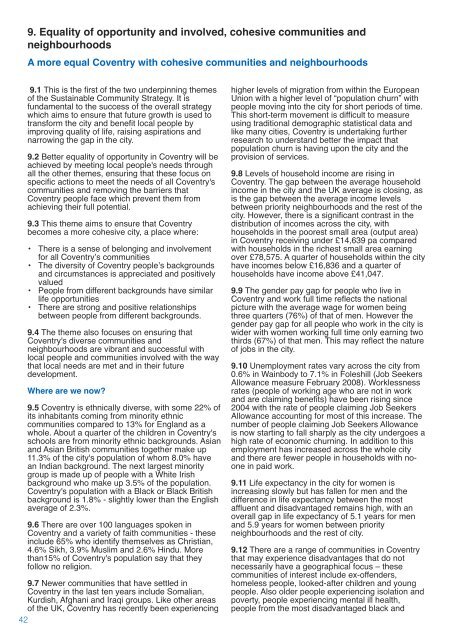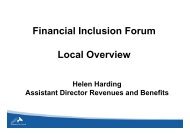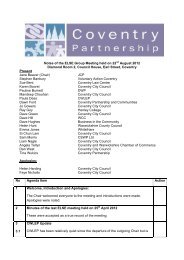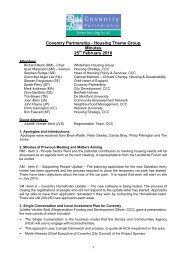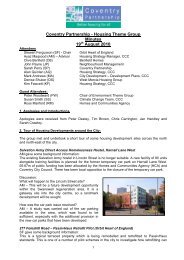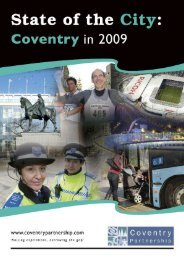Sustainable Community Strategy - Coventry Partnership
Sustainable Community Strategy - Coventry Partnership
Sustainable Community Strategy - Coventry Partnership
Create successful ePaper yourself
Turn your PDF publications into a flip-book with our unique Google optimized e-Paper software.
9. Equality of opportunity and involved, cohesive communities and<br />
neighbourhoods<br />
A more equal <strong>Coventry</strong> with cohesive communities and neighbourhoods<br />
9.1 This is the first of the two underpinning themes<br />
of the <strong>Sustainable</strong> <strong>Community</strong> <strong>Strategy</strong>. It is<br />
fundamental to the success of the overall strategy<br />
which aims to ensure that future growth is used to<br />
transform the city and benefit local people by<br />
improving quality of life, raising aspirations and<br />
narrowing the gap in the city.<br />
9.2 Better equality of opportunity in <strong>Coventry</strong> will be<br />
achieved by meeting local people's needs through<br />
all the other themes, ensuring that these focus on<br />
specific actions to meet the needs of all <strong>Coventry</strong>'s<br />
communities and removing the barriers that<br />
<strong>Coventry</strong> people face which prevent them from<br />
achieving their full potential.<br />
9.3 This theme aims to ensure that <strong>Coventry</strong><br />
becomes a more cohesive city, a place where:<br />
• There is a sense of belonging and involvement<br />
for all <strong>Coventry</strong>ʼs communities<br />
• The diversity of <strong>Coventry</strong> peopleʼs backgrounds<br />
and circumstances is appreciated and positively<br />
valued<br />
• People from different backgrounds have similar<br />
life opportunities<br />
• There are strong and positive relationships<br />
between people from different backgrounds.<br />
9.4 The theme also focuses on ensuring that<br />
<strong>Coventry</strong>'s diverse communities and<br />
neighbourhoods are vibrant and successful with<br />
local people and communities involved with the way<br />
that local needs are met and in their future<br />
development.<br />
Where are we now?<br />
9.5 <strong>Coventry</strong> is ethnically diverse, with some 22% of<br />
its inhabitants coming from minority ethnic<br />
communities compared to 13% for England as a<br />
whole. About a quarter of the children in <strong>Coventry</strong>'s<br />
schools are from minority ethnic backgrounds. Asian<br />
and Asian British communities together make up<br />
11.3% of the city's population of whom 8.0% have<br />
an Indian background. The next largest minority<br />
group is made up of people with a White Irish<br />
background who make up 3.5% of the population.<br />
<strong>Coventry</strong>'s population with a Black or Black British<br />
background is 1.8% - slightly lower than the English<br />
average of 2.3%.<br />
9.6 There are over 100 languages spoken in<br />
<strong>Coventry</strong> and a variety of faith communities - these<br />
include 65% who identify themselves as Christian,<br />
4.6% Sikh, 3.9% Muslim and 2.6% Hindu. More<br />
than15% of <strong>Coventry</strong>'s population say that they<br />
follow no religion.<br />
9.7 Newer communities that have settled in<br />
<strong>Coventry</strong> in the last ten years include Somalian,<br />
Kurdish, Afghani and Iraqi groups. Like other areas<br />
of the UK, <strong>Coventry</strong> has recently been experiencing<br />
42<br />
higher levels of migration from within the European<br />
Union with a higher level of “population churn” with<br />
people moving into the city for short periods of time.<br />
This short-term movement is difficult to measure<br />
using traditional demographic statistical data and<br />
like many cities, <strong>Coventry</strong> is undertaking further<br />
research to understand better the impact that<br />
population churn is having upon the city and the<br />
provision of services.<br />
9.8 Levels of household income are rising in<br />
<strong>Coventry</strong>. The gap between the average household<br />
income in the city and the UK average is closing, as<br />
is the gap between the average income levels<br />
between priority neighbourhoods and the rest of the<br />
city. However, there is a significant contrast in the<br />
distribution of incomes across the city, with<br />
households in the poorest small area (output area)<br />
in <strong>Coventry</strong> receiving under £14,639 pa compared<br />
with households in the richest small area earning<br />
over £78,575. A quarter of households within the city<br />
have incomes below £16,836 and a quarter of<br />
households have income above £41,047.<br />
9.9 The gender pay gap for people who live in<br />
<strong>Coventry</strong> and work full time reflects the national<br />
picture with the average wage for women being<br />
three quarters (76%) of that of men. However the<br />
gender pay gap for all people who work in the city is<br />
wider with women working full time only earning two<br />
thirds (67%) of that men. This may reflect the nature<br />
of jobs in the city.<br />
9.10 Unemployment rates vary across the city from<br />
0.6% in Wainbody to 7.1% in Foleshill (Job Seekers<br />
Allowance measure February 2008). Worklessness<br />
rates (people of working age who are not in work<br />
and are claiming benefits) have been rising since<br />
2004 with the rate of people claiming Job Seekers<br />
Allowance accounting for most of this increase. The<br />
number of people claiming Job Seekers Allowance<br />
is now starting to fall sharply as the city undergoes a<br />
high rate of economic churning. In addition to this<br />
employment has increased across the whole city<br />
and there are fewer people in households with noone<br />
in paid work.<br />
9.11 Life expectancy in the city for women is<br />
increasing slowly but has fallen for men and the<br />
difference in life expectancy between the most<br />
affluent and disadvantaged remains high, with an<br />
overall gap in life expectancy of 5.1 years for men<br />
and 5.9 years for women between priority<br />
neighbourhoods and the rest of city.<br />
9.12 There are a range of communities in <strong>Coventry</strong><br />
that may experience disadvantages that do not<br />
necessarily have a geographical focus – these<br />
communities of interest include ex-offenders,<br />
homeless people, looked-after children and young<br />
people. Also older people experiencing isolation and<br />
poverty, people experiencing mental ill health,<br />
people from the most disadvantaged black and


